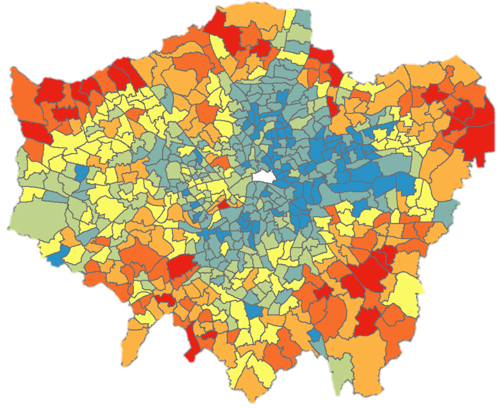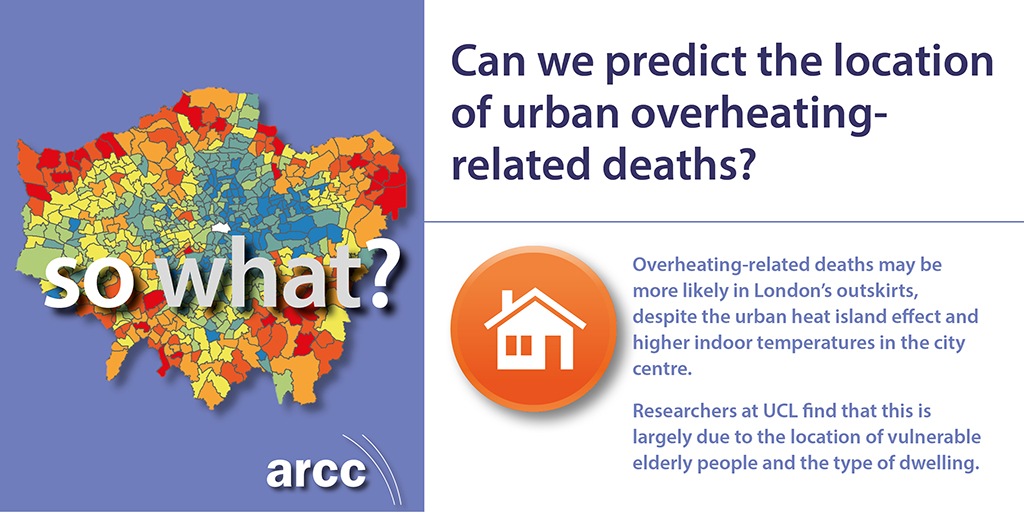New research from UCL indicates that the risk of death during hot weather is most likely in the outskirts of London, where many homes are at risk of overheating, rather than in the city centre, where outdoor temperatures are generally higher.
Researchers combined maps of population age, outdoor temperature variations and indoor temperature estimates for over 2.6 million domestic addresses in London to predict the location at greatest risk of heat-related mortality.
In London, health data indicates that people face an increased risk of death above a temperature threshold of 24.8ºC, with the elderly being at greatest risk. As Londoners typically spend most of their time indoors, the actual temperature exposure of the population will, in part, be determined by building type and local surrounding outdoor temperatures. This is particularly notable in dense urban areas, where day and night temperatures are higher than surrounding, less built-up areas – known as the Urban Heat Island (UHI) effect.
Relevance
In the UK, temperature-related death is usually associated with cold weather. However, heat-related mortality will become increasingly important as the frequency of extreme heat events rises with climate change.
Heat risk thresholds vary across the UK regions. In London, temperatures above the threshold of 24.8ºC increase the risk of mortality, with the elderly being the most vulnerable as temperatures climb.
In a large and diverse city such as London, there is an inevitable spatial variation in population vulnerability to heatwaves:
- some areas have a large elderly population
- there’s a wide range of building type, which has an impact on indoor temperatures
- the UHI varies greatly.
A mathematical relationship between age, temperature, and mortality risk allows us to estimate how many individuals might die during hot weather, based on geographical data. This study found that:
- Heat-related mortality may be highest in Outer London due to the greater elderly population.
- Indoor temperatures showed a larger range than UHI temperatures, suggesting that indoor temperatures play an important role.
- Certain housing types can double the risk of occupants’ heat mortality relative to the average domestic building, e.g. poorly insulated bungalows, or top-floor flats.
- UHI-related temperatures vary, so identifying at-risk areas is difficult. However, it is likely that the London UHI causes around 8 deaths a day during hot weather.
Now what?
People, housing, and local temperatures are important factors in identifying locations that may experience an increase in mortality during hot weather.
We can identify who is most vulnerable to heat, the areas across the city where they live, the types of housing that are at greatest risk of overheating, and the locations where the UHI is greatest.
By combining these different data sources into a model, we are able to identify locations that may need additional attention during hot weather and when developing heatwave plans. The model can also quantify the reduction in mortality offered by implementing adaptation and UHI-reduction strategies such as urban greening, and so informing urban planning decisions. As a result, it is possible to include overheating prevention options in cost-benefit analyses.
Image shows estimated mortality per million population during a warm 55-day period in London.

Residents
- Ensure windows can be opened during hot weather. The risk of mortality in the worst-performing dwelling (bungalow) triples when windows are kept closed while the external temperature is cooler than indoors.
- If possible, sleep in a ground floor room rather than the top floor or loft.
- Consider relocating during hot weather if living in a heat-vulnerable location or building.
Health officials
- Include local population vulnerability, and UHI and indoor temperature risks within emergency heatwave plans.
- Consider developing a heat warning system that incorporates local housing stock and UHI information.
Policymakers / housing associations
- Avoid placing vulnerable individuals in properties at high risk of overheating, or in locations with high UHIs.
- Provide advice and support for people occupying dwellings that are difficult to cool.


